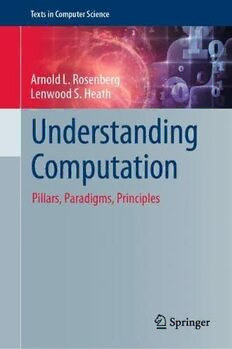
Understanding Computation: Pillars, Paradigms, Principles PDF
Preview Understanding Computation: Pillars, Paradigms, Principles
Texts in Computer Science Arnold L. Rosenberg Lenwood S. Heath Understanding Computation Pillars, Paradigms, Principles Texts in Computer Science Series Editors David Gries, Department of Computer Science, Cornell University, Ithaca, NY, USA OritHazzan ,FacultyofEducationinTechnologyandScience,Technion—Israel Institute of Technology, Haifa, Israel Titles in this series now included in the Thomson Reuters Book Citation Index! ‘TextsinComputerScience’(TCS)delivershigh-qualityinstructionalcontentfor undergraduates and graduates in all areas of computing and information science, with a strong emphasis on core foundational and theoretical material but inclusive of some prominent applications-related content. TCS books should be reasonably self-containedandaimtoprovidestudentswithmodernandclearaccountsoftopics ranging across the computing curriculum. As a result, the books are ideal for semestercoursesorforindividualself-studyincaseswherepeopleneedtoexpand their knowledge. All texts are authored by established experts in their fields, reviewed internally and by the series editors, and provide numerous examples, problems, and other pedagogical tools; many contain fully worked solutions. The TCS series is comprised of high-quality, self-contained books that have broad and comprehensive coverage and are generally in hardback format and sometimes contain color. For undergraduate textbooks that are likely to be more brief and modular in their approach, require only black and white, and are under 275pages,SpringerofferstheflexiblydesignedUndergraduateTopicsinComputer Science series, to which we refer potential authors. Arnold L. Rosenberg Lenwood S. Heath (cid:129) Understanding Computation Pillars, Paradigms, Principles 123 ArnoldL. Rosenberg LenwoodS. Heath University of Massachusetts Virginia Tech Amherst, MA, USA Blacksburg, VA, USA ISSN 1868-0941 ISSN 1868-095X (electronic) Textsin Computer Science ISBN978-3-031-10054-3 ISBN978-3-031-10055-0 (eBook) https://doi.org/10.1007/978-3-031-10055-0 ©TheEditor(s)(ifapplicable)andTheAuthor(s),underexclusivelicensetoSpringerNature SwitzerlandAG2022 Thisworkissubjecttocopyright.AllrightsaresolelyandexclusivelylicensedbythePublisher,whether thewholeorpartofthematerialisconcerned,specificallytherightsoftranslation,reprinting,reuseof illustrations, recitation, broadcasting, reproduction on microfilms or in any other physical way, and transmissionorinformationstorageandretrieval,electronicadaptation,computersoftware,orbysimilar ordissimilarmethodologynowknownorhereafterdeveloped. The use of general descriptive names, registered names, trademarks, service marks, etc. in this publicationdoesnotimply,evenintheabsenceofaspecificstatement,thatsuchnamesareexemptfrom therelevantprotectivelawsandregulationsandthereforefreeforgeneraluse. The publisher, the authors, and the editorsare safeto assume that the adviceand informationin this book are believed to be true and accurate at the date of publication. Neither the publisher nor the authors or the editors give a warranty, expressed or implied, with respect to the material contained hereinorforanyerrorsoromissionsthatmayhavebeenmade.Thepublisherremainsneutralwithregard tojurisdictionalclaimsinpublishedmapsandinstitutionalaffiliations. ThisSpringerimprintispublishedbytheregisteredcompanySpringerNatureSwitzerlandAG Theregisteredcompanyaddressis:Gewerbestrasse11,6330Cham,Switzerland Tomybelovedwife,Susan,forherinfinite patienceduringmyextendedepisodesof “cerebralabsence”. Tomywife,Deanie,alwaystheLoveofMy Life,forherunendingsupportandlove. Contents PREFACE......................................................... xv I: INTRODUCTION............................................... 1 1 IntroducingComputationTheory................................ 3 1.1 TheAutobiographical(ALR)SeedsofOurFramework........... 4 1.1.1 Computationby“Shapeless”AgentsandDevices ......... 4 1.1.2 ComputationTheoryasaStudyofComputation .......... 6 1.2 TheHighlightsofOurFramework:HowWeTelltheStory........ 7 1.3 WhyIsaNewComputationTheoryTextNeeded? ............... 10 2 IntroducingtheBook........................................... 15 2.1 ComputationTheoryasaBranchofDiscreteMathematics ........ 17 2.1.1 DynamismWithinTraditionalMathematics .............. 17 2.1.2 DiscreteMathematicswithComputationalObjects ........ 17 2.2 TheFourPillarsofComputationTheory....................... 20 2.2.1 PillarS:STATE ..................................... 21 2.2.2 PillarE:ENCODING ................................. 22 2.2.3 PillarN:NONDETERMINISM.......................... 26 2.2.4 PillarP:PRESENTATION/SPECIFICATION............... 29 2.2.5 SummingUp........................................ 30 2.3 AMapoftheBookbyChapter ............................... 32 2.4 WaysofUsingthisBook .................................... 36 2.4.1 AsaTextfora“Classical”TheoryCourse ............... 36 2.4.1.1 AutomataandFormalLanguages............... 37 2.4.1.2 ComputabilityTheory ........................ 37 2.4.1.3 ComplexityTheory .......................... 38 2.4.2 AsaPrimaryText:“BigIdeasinComputation”........... 39 2.4.3 AsaSupplementalText:“TheoreticalAspectsof–”........ 42 2.4.3.1 PervasiveTopics:EnhanceManyCourses........ 42 2.4.3.2 FocusedTopics:EnhanceSpecializedCourses.... 44 vii viii Contents 2.5 ToolsforUsingtheBook .................................... 46 II: PillarS:STATE ................................................ 47 3 PureState-BasedComputationalModels ......................... 51 3.1 OnlineAutomataandTheirLanguages ........................ 51 3.1.1 BasicsoftheOAModel............................... 51 3.1.2 PreparingtoUnderstandtheNotionState ................ 57 3.1.3 AMyhill-Nerode-likeTheoremforOAs ................. 62 3.2 FiniteAutomataandRegularLanguages ....................... 64 3.2.1 OverviewandHistory ................................ 64 3.2.2 PerspectivesonFiniteAutomata........................ 67 3.2.2.1 TheFAasanAbstractModel .................. 68 3.2.2.2 OnDesigningFAsforSpecificTasks............ 70 3.2.3 WhyFAsGetConfused:aConsequenceofFiniteness...... 75 4 TheMyhill-NerodeTheorem:ImplicationsandApplications........ 79 4.1 TheMyhill-NerodeTheoremforFAs.......................... 80 4.1.1 TheTheorem:StatesAreEquivalenceClasses ............ 81 4.1.2 WhatDo≡ -EquivalenceClassesLookLike?............ 83 L 4.1.2.1 Language#1:L = {ai|i≡0mod3}.......... 83 1 4.1.2.2 Language#2:L ={x1111y|x;y∈{0;1}?} ..... 85 2 4.1.2.3 Language#3:L ={anbn|n∈N}.............. 86 3 4.1.2.4 TheLanguageof(Binary)Palindromes.......... 87 4.2 SampleApplicationsoftheMyhill-NerodeTheorem ............. 88 4.2.1 ProvingthatLanguagesAreNotRegular ................ 88 4.2.2 OnMinimizingFiniteAutomata........................ 91 4.2.2.1 TheFAState-MinimizationAlgorithm .......... 92 4.2.3 Two-Way(Offline)FiniteAutomata..................... 96 4.2.4 ⊕FiniteAutomatawithProbabilisticTransitions..........101 4.2.4.1 PFAsandTheirLanguages ....................101 4.2.4.2 PFALanguagesandRegularLanguages .........103 A.PFAlanguageswhicharenotRegular ........103 B.⊕⊕PFAlanguageswhichareRegular ........109 4.2.5 ⊕StateasaMemory-ConstrainingResource .............112 4.2.5.1 ApproximatingOAsbyGrowingFAs:Examples..114 4.2.5.2 ApproximatingOAsbyGrowingFAs:General Case.......................................115 5 OnlineTuringMachinesandtheImplicationsofOnlineComputing..119 5.1 OnlineTuringMachines:RealizationsofInfiniteOAs ............120 5.1.1 OTMswithAbstractStorageDevices ...................120 5.1.2 OTMswithLinearTapesforStorage....................122 5.2 TheNatureofOnlineComputing .............................129 5.2.1 OnlineTMswithMultipleComplexTapes ...............130 5.2.2 AnInformation-RetrievalProblemasaLanguage .........132 Contents ix 5.2.3 TheImpactofTapeStructureonMemoryLocality ........134 5.2.4 TapeDimensionalityandtheTimeComplexityofL .....135 DB 6 Pumping:ComputationalPigeonholesinFinitarySystems..........139 6.1 IntroductionandSynopsis ...................................139 6.2 PumpinginAlgebraicSettings ...............................140 6.3 PumpinginRegularLanguages...............................142 6.3.1 PumpinginGeneralRegularLanguages .................143 6.3.2 PumpinginRegularTallyLanguages ...................147 6.3.2.1 ACharacterizationoftheRegularTallyLanguages147 6.3.2.2 ⊕APurelyCombinatorialCharacterization ......150 6.4 PumpinginaRoboticSetting:aMobileFAonaMesh ...........150 6.4.1 TheMeshM andItsSubdivisions.....................150 n 6.4.2 TheMobileFiniteAutomaton(MFA)Model .............153 6.4.3 AnInherentLimitationonSoloAutonomousMFAs .......153 7 MobilityinComputing:AnFANavigatesaMesh ..................157 7.1 IntroductionandSynopsis ...................................157 7.2 MFAsThatComputeinRead-OnlyMode ......................160 7.2.1 HowanMFACanExploittheStructureofItsHostMesh...160 7.2.1.1 “BouncingOffWalls”toExploitSymmetries.....160 7.2.1.2 ApproximatingRational-SlopePathsWithinM .161 n 7.2.2 SoloMFAsScalablyRecognizeNon-RegularLanguages...163 7.2.2.1 MatchingForwardandBackwardPatterns .......164 7.2.2.2 MatchingDistinctForwardPatterns.............166 7.3 MFAsasObject-TransportingRobots..........................169 7.3.1 ReversingM’sTop-RowPatterntoItsBottomRow.......170 7.3.2 ⊕RotatingM’sTop-RowPatterntoItsBottomRow......171 7.3.3 AlgorithmsthatCircumnavigateM’s“Walls” ............173 7.3.3.1 Sorting-BasedRearrangements.................176 7.3.3.2 ⊕Pattern-Checkingvs.PatternGeneration.......179 8 ThePowerofCooperation:TeamsofMFAsonaMesh .............183 8.1 BasicsofMFATeams.......................................183 8.2 StrictlyCoupledMFAs:ParallelismwithNoAddedPower........186 8.3 SynchronizedComputing:A2-MFARecognizes{akbk}..........188 8.4 QueuedComputing:MFAsProceedThroughaPipeline ..........192 8.4.1 The“Standard”FormofPipelining .....................192 8.4.2 StreamingaPipeline/QueueofAgents ..................194 8.5 UsheredComputing:TwoMFAsSweepaMesh-Quadrant ........196 8.6 Sentry-EnabledComputing:MFAsIdentifyHomeWedges........198 III: PillarE:ENCODING ............................................201 x Contents 9 CountabilityandUncountability:ThePrecursorsofENCODING....203 9.1 EncodingFunctionsandProofsofCountability .................206 9.2 Diagonalization:ProofsofUncountability......................212 9.3 WhereHas(Un)CountabilityLedUs? .........................214 10 ComputabilityTheory ..........................................217 10.1 IntroductionandHistory.....................................217 10.1.1 FormalizingMathematicalReasoning ...................217 10.1.2 AbstractComputationalModels:theChurch-TuringThesis .218 10.1.3 ThinkingAboutThinkingAboutComputation............221 10.2 Preliminaries ..............................................223 10.2.1 ComputationalProblemsasFormalLanguages ...........223 10.2.2 FunctionsandPartialFunctions ........................225 10.2.3 Self-ReferentialPrograms:InterpretersandCompilers .....227 10.3 TheHaltingProblem:The“Oldest”UnsolvableProblem .........228 10.3.1 TheHaltingProblemIsSemisolvablebutNotSolvable.....229 10.3.2 WhyWeCareAbouttheHaltingProblem—AnExample...232 10.4 MappingReducibility.......................................234 10.4.1 BasicPropertiesofm-Reducibility......................236 10.4.2 Thes-m-nTheorem:AnInvaluableSourceofEncodings ...238 10.5 TheRice-Myhill-ShapiroTheorem............................240 10.6 Complete—or“Hardest”—SemidecidableProblems .............245 10.7 SomeImportantLimitationsofComputability ..................248 11 AChurch-TuringZooofComputationalModels...................251 11.1 TheChurch-TuringThesisandUniversalModels................251 11.2 UniversalityinSimplifiedOTMs..............................253 11.2.1 AnOTMwithaOne-EndedWorktape...................253 11.2.2 AnOTMwithTwoStacksInsteadofaWorktape ..........256 11.2.3 AnOTMwithaFIFOQueueInsteadofaWorktape .......260 11.2.4 AnOTMwitha“Paper”Worktape .....................265 11.2.5 ⊕AnOTMwithRegistersInsteadofaWorktape .........269 11.2.6 ⊕AMobileFAonaSemi-InfiniteMesh.................276 11.3 EnhancedOTMsthatAreNoMorePowerfulthanOTMs .........278 11.3.1 AnOTMWhichHasSeveralLinearWorktapes ...........278 11.3.2 AnOTMHavingMultidimensionalWorktapes............283 11.3.3 AnOTMHavinga“Random-Access”Worktape ..........287 11.4 ⊕ModelsOutsidetheClassicalMold .........................291 11.4.1 CellularAutomataandKindredModels .................292 11.4.1.1 TheCellularAutomatonModel ................293 11.4.1.2 CAsAreComputationallyEquivalenttoOTMs ...296 11.4.2 TMsasVolunteers;SimulationbyDovetailing............297 11.4.2.1 AbstractVolunteerComputing(VC) ............297 11.4.2.2 TheAbstractVCModelIsComputable..........298 11.5 LearningfromtheZoo ......................................299
